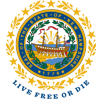Frequently Asked Questions
The New Hampshire Department of Safety's Division of Homeland Security & Emergency Management's mission is to partner with the whole community to mitigate, prepare, respond, recover and prevent all hazards for the State of New Hampshire.
What does Homeland Security & Emergency Management do?
The Division of Homeland Security & Emergency Management combines the traditional emergency management roles of planning for natural and manmade disasters with protecting the state against terrorism. In many ways it mirrors the activities of the federal Department of Homeland Security. The agency director is the state's designated contact with the U.S. Department of Homeland Security and is the conduit through which information on potential security threats are conveyed from the federal to the state government. Combining the state's homeland security functions with emergency management was done through legislation passed in 2006. The agency was created in 1950 as the New Hampshire Civil Defense Agency. It became the Office of Emergency Management in 1987 and became part of the Department of Safety in 2002.
How does the Division respond to a major disaster?
The Division's role in a major disaster is to coordinate the state’s emergency response. Most emergencies start and end at the local level and are handled by local police, fire and emergency medical personnel. Homeland Security & Emergency Management becomes involved when an emergency overwhelms local and mutual aid resources and additional help is needed from the state and federal governments. The Governor directs the state emergency response and requests assistance from other states or the federal government through the agency.
Can the state get federal aid for any disaster?
Federal disaster aid is a last resort and is intended to get communities badly hurt by disasters back on their feet and functioning. It is made available only after local resources are overwhelmed and a declaration of a major disaster is made by the president. The Stafford Act is the main federal disaster aid program. It provides assistance to repair or rebuild damaged public infrastructure such as roads, bridges and buildings. If a preliminary damage assessment finds damage above a minimum threshold, the president may declare a federal disaster. That triggers financial aid through the Federal Emergency Management Agency (now part of the U.S. Department of Homeland Security) that pays 75 percent of repair costs. The state and/or local governments are responsible for the remaining 25 percent.
Does federal aid cover private homes or businesses?
The U.S. Federal Emergency Management Agency can provide Individual Assistance in cases of very serious disasters. This can take the form of vouchers for food and clothing, rental assistance for people displaced from their homes and financial aid for repairs to homes. This aid is provided on a case-by-case basis, usually in conjunction with assistance from the Small Business Administration and other federal and private agencies. The Small Business Administration also provides assistance to businesses affected by disasters, usually in the form of low interest loans.
What kinds of disasters does New Hampshire experience?
New Hampshire is quite fortunate compared to other parts of the country when it comes to natural disasters. Major disasters are rare here because of the state’s location and topography. Still, they can and do happen. In October 2005 and again in May 2006, New Hampshire experienced severe flooding that caused more than $14 million in damage each time. The October 2005 flood was concentrated in the southwestern part of the state. It killed seven people and swept away homes and roads. The May 2006 flood affected a larger area but caused no fatalities. These back-to-back storms were the worst disasters the state experienced since the Hurricane of 1938. Floods, hurricanes and severe winter storms are the most common natural disasters in New Hampshire, although earthquakes and high wind events are also possible.
What about manmade disasters?
New Hampshire has many industrialized areas and these have the potential for manmade disasters. Hazardous materials of all types travel by road, rail and water, so industrial or transportation accidents are possible just about anywhere in the state. New Hampshire’s regional hazardous materials response teams, operated by local fire departments, are equipped and trained to deal with HAZMAT incidents. New Hampshire also falls within the 10-mile emergency planning zone of Seabrook Station, a nuclear power plant located in Seabrook. Homeland Security & Emergency Management plays a central role in emergency planning for the plant.



